You can help expand this article with text translated from the corresponding article in Polish. (June 2014) Click for important translation instructions.
|
| Zantedeschia | |
|---|---|
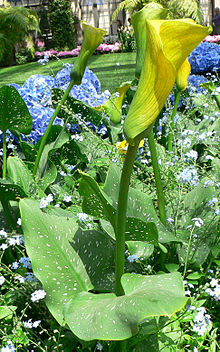
| |
| Zantedeschia elliottiana | |
| Scientific classification | |
| Kingdom: | Plantae |
| Clade: | Tracheophytes |
| Clade: | Angiosperms |
| Clade: | Monocots |
| Order: | Alismatales |
| Family: | Araceae |
| Subfamily: | Aroideae |
| Tribe: | Zantedeschieae |
| Genus: | Zantedeschia Spreng. Syst. Veg., ed. 16. 3: 765 (1826), nom. cons. |
| Type species | |
| Calla aethiopica L. | |
| Synonyms | |
Zantedeschia (/ˌzæntɪˈdɛskiə/) is a genus of eight species of herbaceous, perennial, flowering plants in the aroid family, Araceae, native to southern Africa(from South Africa northeast to Malawi). The genus has been introduced, in some form, on every continent (minus Antarctica).
Common names include arum lily for Z. aethiopica, calla and calla lily for Z. elliottiana and Z. rehmannii. However, members of this genus are not true lilies (which belong to the family Liliaceae), and the genera Arum and Calla, although related, are distinct from Zantedeschia, despite visual similarities. The colourful flowers and leaves, of both species and cultivars, are greatly valued and commonly grown as ornamental and garden plants.
Description
Zantedeschia species are rhizomatous, herbaceous, perennial plants with some species, e. g., Zantedeschia aethiopica, growing to 1.2m tall, while Zantedeschia rehmannii does not exceed 60 cm in height, growing in clumps or clusters.
Roots: Contractile, emerging from the top of the tubers in Group II.
Stem: The underground portion is variously described as a thick underground stem, i. e., a rhizome or tuber. While the literature is confusing as to the exact terminology, generally the Zantedeschia aethiopica-Zantedeschia odorata group (Group I) is considered to have rhizomes and the remaining species tubers. The rhizomes are fleshy and branched.


Leaves: Petioles are long, spongy, sheathed at the bases, and of varying lengths, from 15 cm (Zantedeschia rehmannii) to 1.5 m (Zantedeschia aethiopica). The lamina is simple, elongated, and coriaceous with a variety of shapes, including triangular, oval (ovate), with or without a point (elliptic), heart-shaped (cordate), spear-shaped (hastate), lance-shaped (lanceolate), oblong, or circular (orbicular). 15–60 cm in length, 5–25 cm in width. The leaves are dark green in colour, feather-veined (pinnate), and may be erect or spreading with undulate margins. Some species exhibit transparent flecking (maculation), and are therefore described as maculate, while others are immaculate. (see Table I, also New Zealand Calla Council Leaf Shape Images) The leaves contain hydathodes that result in guttation.
| Species | Leaf shape | Leaf size | Maculation |
|---|---|---|---|
| Z. aethiopica | Ovate-cordate or hastate | 15–45×10–25 cm | rare |
| Z. odorata | Ovate to cordate | none | |
| Z. albomaculata subsp. albomaculata |
Oblong-hastate | 20–50×6–8 cm | rare |
| Z. albomaculata subsp. macrocarpa |
Triangular-hastate | 18–20×5–7 cm | sparse |
| Z. valida | Ovate to cordate to ovate-orbicular-cordate | none | |
| Z. elliottiana | Orbicular-ovate | 22×18 cm | present |
| Z. jucunda | Triangular-hastate | dense | |
| Z. pentlandii | Oblong-elliptic to oblong-lanceolate | seldom | |
| Z. rehmannii | Lanceolate | 20–30×3 cm | none |

Inflorescence: Takes the form of a solitary pseudanthium (false flower), with a showy white or yellow spathe (a specialised petal like bract) shaped like a funnel with a yellow, central, finger-like spadix, which carries the true flowers. Both spathe and spadix are carried on or above the leaves on the fleshy flower stem. The shape of the spathe whose overlapping margins form the tubes varies from trumpet shaped (Z. pentlandii) to a tight tube with a tapering tip (Z. rehmannii). The spathe is initially green, but as it unfolds becomes coloured. This may be white as in Z. aethiopica, but other species include yellow and pink. Cultivars have a wide variety of other spathe colours including orange and purple. Inside the spathe, the throat may be darkly coloured. The spathe acts to attract pollinators.
Flowers: Zantedeschia is monoecious, in which separate male (staminate) and female (pistillate) flowers ("imperfect" or "unisexual" flowers) are carried on the spadix. The flowers are small and non-blooming without a perianth. The male flowers contain two to three stamens fused to form a synandrium, and the female flowers have a single, compound pistil with three fused carpels and three locules.
| Species | Spathe colour | Flowering period | Throat darkened |
|---|---|---|---|
| Z. aethiopica | white-pink | late winter - late spring | No |
| Z. odorata | white | late winter - late spring | No |
| Z. albomaculata subsp. albomaculata |
white-pale yellow-coral pink | late winter | Yes |
| Z. albomaculata subsp. macrocarpa |
yellow | summer | Yes |
| Z. valida | cream | summer | Yes |
| Z. elliottiana | gold-yellow | summer | Yes |
| Z. jucunda | gold-yellow | summer | Yes |
| Z. pentlandii | lemon-chrome yellow | summer | Yes |
| Z. rehmannii | white-pink-maroon | summer | No |
Fruit: Beaked orange or red berries.
Taxonomy
Zantedeschia is the sole genus in the tribe Zantedeschieae in a 1997 classification of the Araceae.
Species

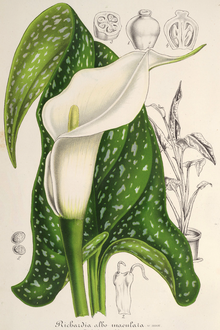
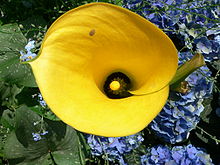

Eight species are currently recognized:
- Zantedeschia aethiopica (L.) Spreng. – giant white arum lily or common arum lily - South Africa, Eswatini, Lesotho
- Zantedeschia albomaculata (Hook.) Baill. – spotted arum lily - widespread from South Africa north to Nigeria and Tanzania
- Zantedeschia elliottiana (W.Watson) Engl. – yellow or golden arum lily - Mpumalanga Province of South Africa
- Zantedeschia jucunda Letty - Leolo Mountains of northern South Africa
- Zantedeschia odorata P.L.Perry - Western Cape Province
- Zantedeschia pentlandii (R.Whyte ex W.Watson) Wittm. - Mpumalanga Province of South Africa
- Zantedeschia rehmannii Engl. – pink arum lily - South Africa, Eswatini, Mozambique
- Zantedeschia valida (Letty) Y.Singh - KwaZulu-Natal Province of South Africa
Etymology
The name of the genus was given as a tribute to Italian botanist Giovanni Zantedeschi (1773–1846) by the German botanist Kurt Sprengel (1766–1833).
Distribution and habitat
All species are endemic to central and southern Africa, from Nigeria to Tanzania and South Africa. Z. aethiopica grows naturally in marshy areas and is only deciduous when water becomes scarce. It grows continuously when watered and fed regularly and can survive periods of minor frosts. Z. aethiopica is a very strong and sturdy plant, being able to grow in many soils and habitats, multiplying by rhizome-offsets; it is naturalised and regarded as a weed throughout much of the world. Z. odorata is a rare species, resembling Z. aethiopica, but deciduous and smelling like freesia, endemic to a few localities in South Africa. Z. albomaculata is a widespread and variable species, growing from South Africa north to Kenya, varying in shades of white to cream and pink to orange-shades. Z. jucunda and Z. pentlandii are rare species with large yellow showy flowers. Z. rehmannii is a pink-flowered species with sword shaped leaves. Z. elliotiana is known from horticultural sources only and is probably of hybrid origin.
Introduction
Zantedeschia was introduced to Europe in the seventeenth century as Z. aethiopica, and is now widely naturalised in Europe, North America, Central America, South America, Oceania, and Australasia. In many places it is considered a dangerous invasive species that displaces native vegetation. In the South-West of Western Australia, Z. aethiopica was introduced for horticulture, but has become a widespread and conspicuous weed of watercourses, heath, and wet pastures to the extent that it has been declared a pest in Western Australia and landowners must control it and attempts to sell plants must be reported. Zantedeschia in North America is primarily grown as ornamental cultivars in home gardens.
Habitat
Z. aethiopica grows naturally in marshy areas and is only deciduous when water becomes scarce. It grows continuously when watered and fed regularly and can survive periods of minor frosts. Z. aethiopica is a very strong and sturdy plant, being able to grow in many soils and habitats, multiplying by rhizome-offsets.
Cultivation
All Zantedeschia produce large, showy flowers spathes and are often grown both as ornamental plants and for cut flowers. Zantedeschia are relatively hardy plants, but some are more winter-hardy than others. In this regard there may be considered two groups, a hardy outdoor group with large white flowers (arum lilies) and less hardy group with white-spotted leaves and flowers in many colours (calla lilies), such as yellow, orange, pink and purple.
Hardy forms (arum lilies)
These include Zantedeschia aethiopica and Zantedeschia pentlandii and their cultivars. Zantedeschia aethiopica and some of its relatives can survive at minimum winter temperatures below -23 °C (USDA Zone 6) and many others can be grown in even warmer areas where all the ground does not freeze (USDA Zone 7). Z. pentlandii hybrids include 'Millennium Gold'.
Tender forms (calla lilies)
The more tender specimens are mainly cultivars (hybrids) of Zantedeschia elliotiana and Zantedeschia rehmannii (referred to as elliotiana or rehmannii cultivars or hybrids, or as e.g. Z. × rehmanii), but also Zantedeschia albomaculata and Zantedeschia jucunda. These less hardy forms can only survive winter temperatures to −12 °C (Zones 8). This plant must be grown as tender bulbs or houseplants in cooler areas. Species and hybrids between Z. elliotiana, Z. jucunda, Z. pentlandii and Z. rehmannii appear to have an optimum temperature for growth near 25 °C, with growth being suppressed once daily average temperatures persist at 28 °C.
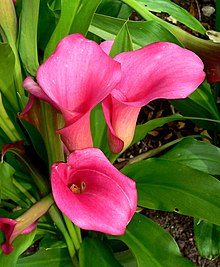
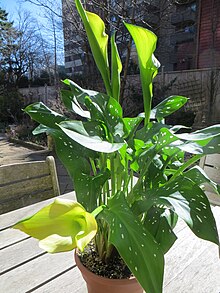
Z. rehmannii hybrids include 'Amethyst', 'Crystal Blush' and 'Neon Amour', while an example of a Z. elliotiana × Z. rehmannii hybrid would be 'Blaze'. Z. elliotiana × Z. maculata hybrids include 'Lemon Drop'. Z. elliotiana hybrids include 'Solar Flare'.
Seasonal grouping
Other classifications consider two groups based on their seasonal habits. Zantedeschia aethiopica and Zantedeschia odorata form one group (Group I) typified by retaining their leaves in winter, and flowering from late winter to late spring, while the remaining species (Group II) are in leaf from spring to late autumn shedding their leaves in winter (deciduous) and flower during the summer. Zantedeschia aethiopica may retain its leaves all year round (evergreen), otherwise from autumn to late summer, while Zantedeschia odorata retains its leaves from late winter to late spring. The two groups also vary according to the arrangement of the male and female organs. In the first group they are arranged together in the lower part of the spadix, whereas in the latter they are separate, with the female at the base. The Z. aethiopica group also have a fruit that turns soft and orange, whereas the other retains a firm green fruit.
Toxicity
Zantedeschia shares the general properties of the family Araceae in causing contact irritation. Zantedeschia species are also poisonous due to the presence of calcium oxalate crystals in the form of raphides. All parts of the plant are poisonous, typically producing local irritation or a burning sensation in the mouth and occasionally vomiting and diarrhea. However leaves are sometimes cooked and eaten.
Uses
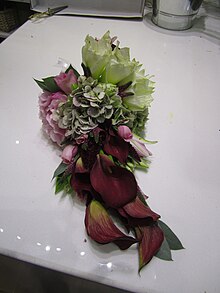
Extensive commercial production of Zantedeschia for cut flowers and/or planting material occurs in California, Colombia, New Zealand and Kenya. Plant breeders in California and New Zealand continue to produce an extensive range of new hybrid cultivars. The so-called white calla derived from Z. aethiopica. All varieties with flowers with shades of yellow, orange, red, purple are mainly derived from Z. albomaculata, Z. pentlandii, Z. elliottiana and Z. rehmanni.
Culture
Zantedeschia has often been used in paintings and is featured in many of Diego Rivera's works of art (see The Flower Vendor, amongst others). It was a favourite subject of the painter Georgia O'Keeffe.
References
- ^ "Zantedeschia". Plants of the World Online. Royal Botanic Gardens, Kew. Retrieved 17 October 2023.
- "Zantedeschia". Tropicos. Missouri Botanical Garden. Retrieved 17 October 2023.
- Brenzel, Kathleen Norris, ed. (March 1995). Sunset Western Garden Book (6 ed.). Menlo Park, California: Sunset Publishing Corporation. pp. 606–607. ISBN 978-0376038500.
- ^ Lehnebach, Carlos A.; Regnault, Claire; Rice, Rebecca; Awa, Isaac Te; Yates, Rachel A. (2023-11-01). Flora: Celebrating our Botanical World. Te Papa Press. p. 97. ISBN 978-1-9911509-1-2.
- ^ K.A. Funnell (2006) . "The genus Zantedeschia. Botanical Classification and Morphology". New Zealand Calla Council. Archived from the original on 24 April 2014. Retrieved 21 April 2014.
- ^ Aubrey, Alice (November 2001). "Zantedeschia aethiopica". PlantZAfrica. South African National Biodiversity Institute. Retrieved 15 October 2023.
- ^ Adolf Engler, ed. (1915). "58. Zantedeschia". Das Pflanzenreich: regni vegetablilis conspectus (in Latin). Vol. 64 IV. Leipzig: Wilhelm Engelmann Verlag. p. 61. Retrieved 27 April 2014.
- Govaerts, Rafaël; Frodin, David G (25 July 2002). World Checklist and Bibliography of Araceae (and Acoraceae). The Board of Trustees of the Royal Botanic Gardens, Kew. ISBN 9781842460368.
- Podbielkowski, Zbigniew (1989). "Kallijka etiopska". Słownik roślin użytkowych (in Polish). Warszawa: Państwowe Wydawnictwo Rolnicze i Leśne. p. 138. ISBN 83-09-00256-4.
- ^ Burrows, George E.; Ronald J. Tyrl (2012). "Zantedeschia". Toxic Plants of North America (2 ed.). John Wiley & Sons. pp. 141–142. ISBN 978-1118413395. Retrieved 29 April 2014.
- Botanica's Annuals & Perennials. Australia: Laurel Glen Publishing. 2003. p. 938. ISBN 978-1571456489.
- Mayo, Simon Joseph; Bogner, Joseph; Boyce, Peter Charles (1 September 1997). The Genera of Araceae. The Trustees of Royal Botanic Gardens, Kew. p. 232. ISBN 978-1900347228. Retrieved 17 October 2023.
- "Zantedeschia aethiopica". Germplasm Resources Information Network. Agricultural Research Service, United States Department of Agriculture. Retrieved 21 April 2014.
- "Zantedeschia aethiopica". Global Biodiversity Information Facility. Retrieved 17 October 2023.
- "Zantedeschia aethiopica". Global Invasive Species Database. International Union for Conservation of Nature. 14 March 2008. Retrieved 17 October 2023.
It grows in dense stands preventing the regeneration of local flora.
- "Arum lily: Declared pest".
- ^ "How to grow Zantedeschia". RHS. Royal Horticultural Society. Retrieved 17 October 2023.
- "Millennium Gold". Pacific Callas. Archived from the original on 5 January 2016. Retrieved 17 October 2023.
- ^ Funnell, Keith Allen (1993). "36. Zantedeschia". In De Hertogh, August A; Le Nard, Marcel (eds.). The Physiology of flower bulbs. Amsterdam: Elsevier Science. pp. 683–704. ISBN 9780444874986.
- "Amethyst". Pacific Callas. Archived from the original on 11 June 2015. Retrieved 17 October 2023.
- "Crystal Blush". Pacific Callas. Archived from the original on 4 March 2016. Retrieved 17 October 2023.
- "Neon Amour". Pacific Callas. Archived from the original on 4 March 2016. Retrieved 17 October 2023.
- "Blaze". Pacific Callas. Archived from the original on 4 March 2016. Retrieved 17 October 2023.
- "Lemon Drop". Pacific Callas. Archived from the original on 24 September 2015. Retrieved 17 October 2023.
- "Solar Flare". Pacific Callas. Archived from the original on 4 March 2016. Retrieved 17 October 2023.
- Slaughter, Robin J; Beasley, D Michael G; Lambie, Bruce S; Wilkins, Gerard T; Schep, Leo J (14 December 2012). "Poisonous plants in New Zealand: a review of those that are most commonly enquired about to the National Poisons Centre". The New Zealand Medical Journal. 125 (1367): 93–96. ISSN 1175-8716. PMID 23321887. Retrieved 17 October 2023.
- Miles, Jackie (2002-09-12). "Arum or calla lily (Zantedeschia aethiopica )". South Coast Weeds. Eurobodalla Shire Council. Archived from the original on 2012-07-29. Retrieved 2007-11-18.
- "Zantedeschia aethiopica". Plants for a Future. Retrieved 17 October 2023.
External links
- "California Callas". Pacific Callas. Archived from the original on 4 March 2016. Retrieved 17 October 2023.
- "Zantedeschia". Germplasm Resources Information Network. Agricultural Research Service, United States Department of Agriculture.
- "Zantedeschia aethiopica". Ecology & Evolutionary Biology. University of Connecticut. 11 October 2023. Retrieved 17 October 2023.
- "Zantedeschia elliottiana". Ecology & Evolutionary Biology. University of Connecticut. 18 May 2017. Archived from the original on 21 May 2017. Retrieved 17 October 2023.
- Snijder, Ronald Christiaan (13 February 2004). Genetics of Erwinia resistance in Zantedeschia: impact of plastome-genome incompatibility (PDF) (PhD thesis). Wageningen University & Research. ISBN 90-5808-975-4.